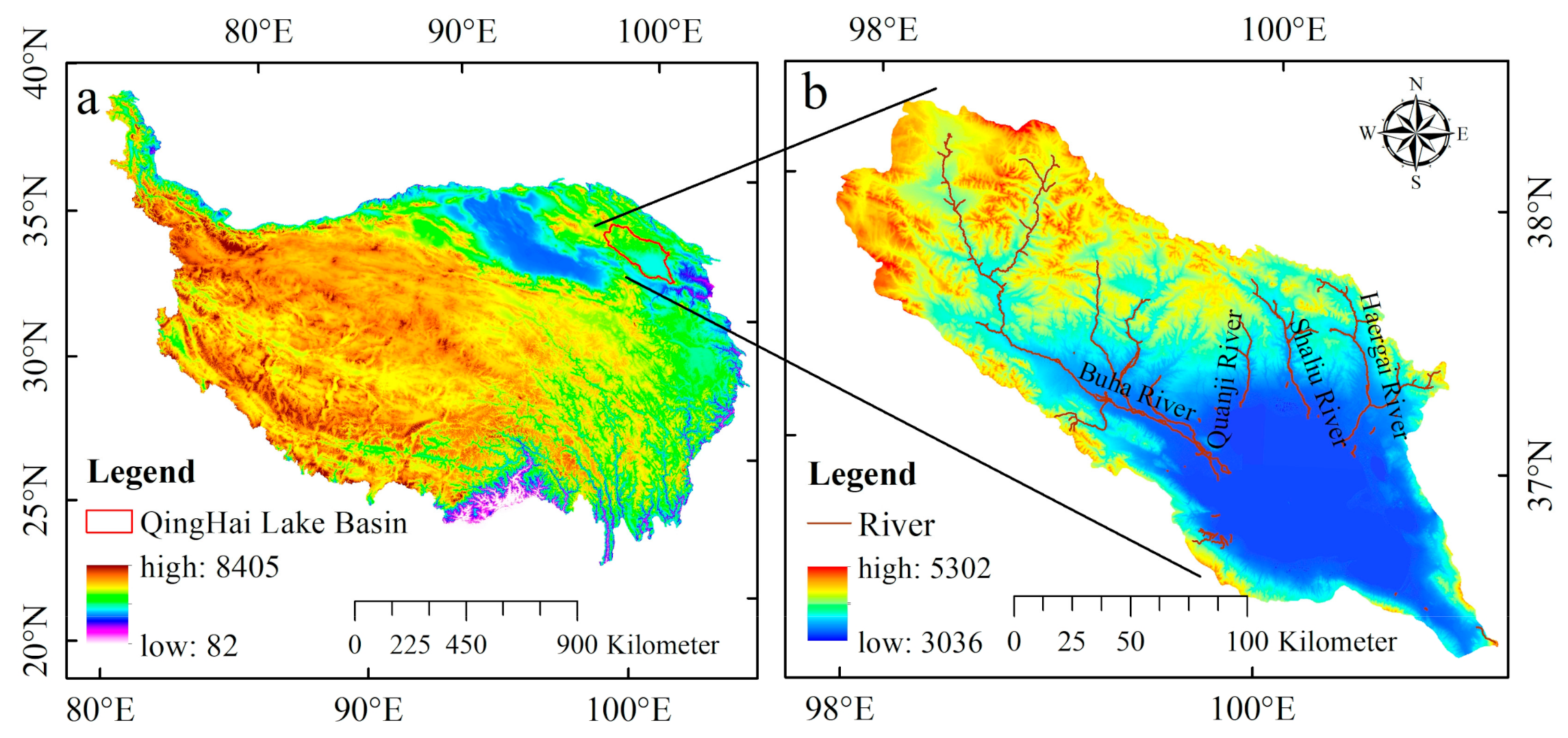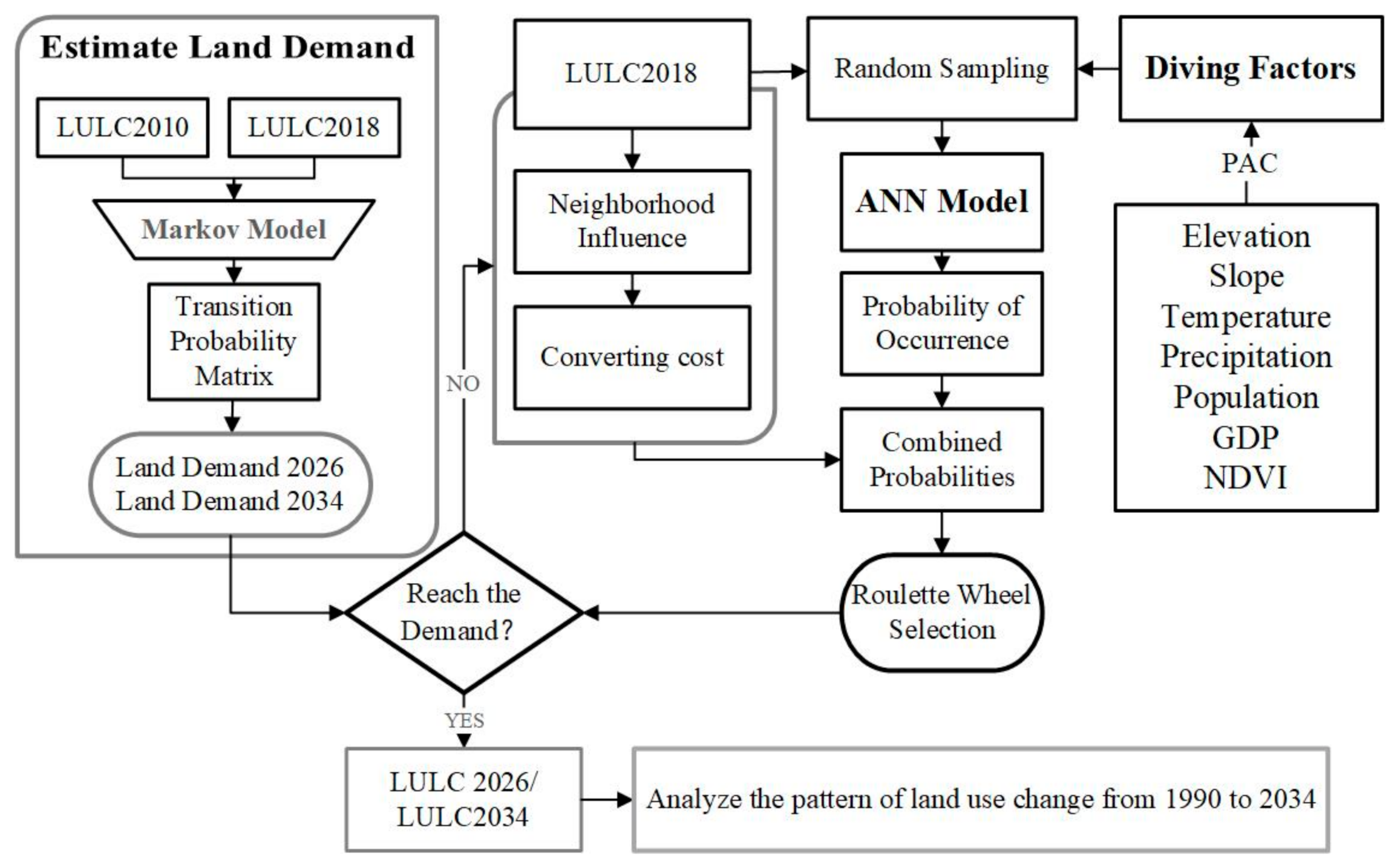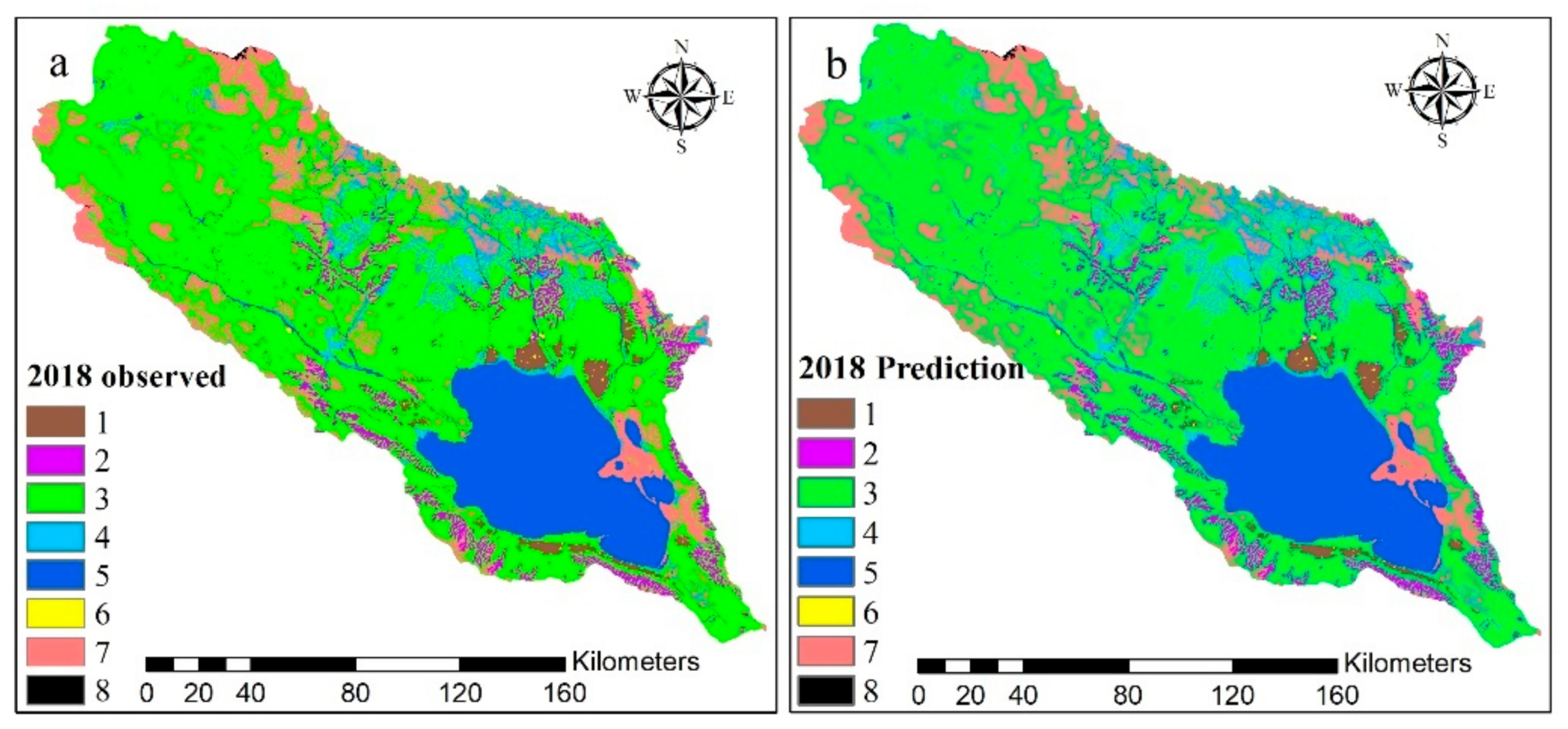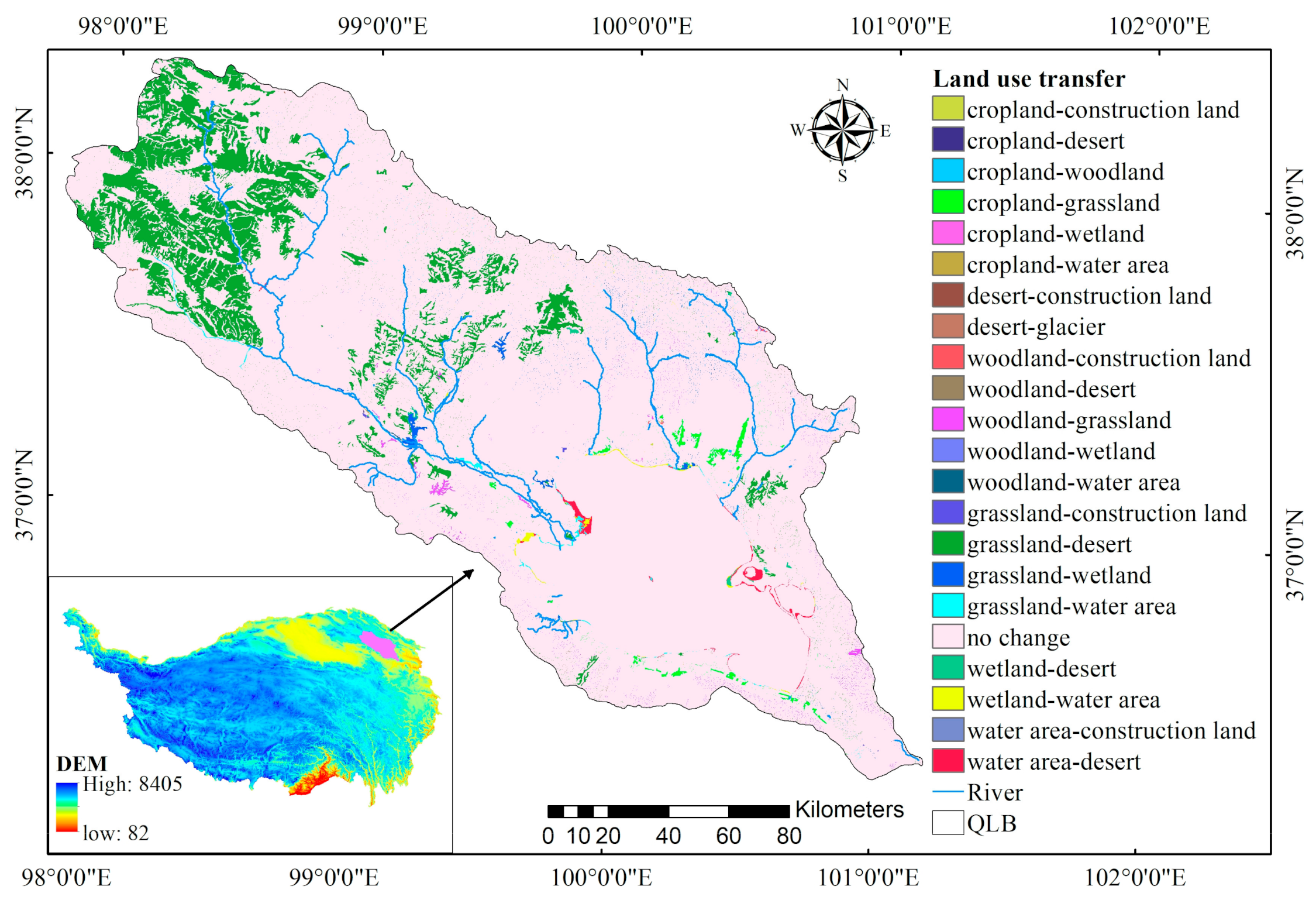Evolution and Prediction of Landscape Patterns in the Qinghai Lake Basin
Abstract
:1. Introduction
2. Materials and Methods
2.1. Study Area
2.2. Data Source and Processing
2.3. Methodology
2.4. Future Land Use Simulation Model (FLUS)
3. Results
3.1. FLUS Model Performance
3.2. LULC Changes for the Period from 1990 to 2018
3.3. Estimated LULC Changes for the Period from 2018 to 2034
4. Discussion
5. Conclusions
- (1)
- A comprehensive consideration of the natural, economic, and ecological factors, using the Markov model and the FLUS model, based on the change direction of landscape types from 2010 to 2018, can be used to predict the numerical changes and spatial distribution characteristics of landscape types in 2026 and 2034. At the same time, the simulated 2018 landscape type map and the 2018 actual landscape type map were used to evaluate the accuracy of the model. The results show that the overall accuracy and Kappa coefficient distribution of the FLUS model were 0.98 and 0.97, indicating the simulation results were relatively reliable.
- (2)
- During the period from 2000 to 2018, the grassland area of the QLB increased by 30.32 × 108 m2, the desert area decreased by 31.43 × 108 m2, and 31.86 × 108 m2 of desert was transformed into grasslands, accounting for 10.75% of the total area of the basin, indicating that the desert areas have been greatly reduced and converted into grasslands. The direct reason for the significant expansion of the grassland area is the implementation of policies and activities, such as the project of the GGP, the comprehensive management of the ecological environment in the QLB, and the ecological environment protection of the QLB. At the same time, the transformation of deserts into grasslands also benefited from natural factors, such as the climate in the basin tending to be warm and wet, resulting in an increase in vegetation coverage, and an active water cycle during this period.
- (3)
- In the 16-year period from 2018 to 2034, the proportion of various landscapes will change slightly, and meanwhile the spatial distribution will be stable.
Author Contributions
Funding
Data Availability Statement
Acknowledgments
Conflicts of Interest
References
- Salazar, A.; Baldi, G.; Hirota, M.; Syktus, J.; Mcalpine, C. Land use and land cover change impacts on the regional climate of non-Amazonian South America: A review. Glob. Planet. Chang. 2015, 128, 103–119. [Google Scholar] [CrossRef]
- Gutman, G.; Justice, C.; Sheffner, E.; Loveland, T. The NASA Land Cover and Land Use Change Program; Land Change Science; Springer: Berlin/Heidelberg, Germany, 2012; pp. 17–29. [Google Scholar]
- Gao, F.; Ma, Q.; Shan, P.; Yang, D.; Guo, X.; Yang, S.; Zhang, Z. Land Use/Cover Change and Hot Spots Analysis in Muffling City of Heilongjiang Province. Areal Res. Dev. 2016, 35, 126–130. [Google Scholar]
- Jaarsveld, A.; Biggs, R.; Scholes, R.J.; Bohensky, E.; Fabricius, C. Measuring conditions and trends in ecosystem services at multiple scales: The Southern African Millennium Ecosystem Assessment (SAfMA) experience. Philos. Trans. R. Soc. Lond. 2005, 360, 425–441. [Google Scholar] [CrossRef] [Green Version]
- Liu, J.; Kuang, W.; Zhuang, Z.; Xu, X.; Qin, Y.; Ning, J.; Zhou, W.; Zhang, S.; Li, R.; Yan, C.; et al. Spatiotemporal characteristics, patterns and causes of land use changes in China since the late 1980s. J. Geogr. Sci. 2014, 24, 195–210. [Google Scholar] [CrossRef]
- Mooney, H.A.; Duraiappah, A.; Larigauderie, A. Evolution of natural and social science interactions in global change research programs. Proc. Natl. Acad. Sci. USA 2013, 110, 3665–3672. [Google Scholar] [CrossRef] [Green Version]
- Wang, C.; Zhang, B.; Zhang, S. Study on the effects of land use change on ecosystem service values of Jilin Province. J. Nat. Resour. 2004, 19, 55–61. [Google Scholar]
- Ramachandra, T.V.; Bharath, S.; Gupta, N. Modelling landscape dynamics with LST in protected areas of Western Ghats, Karnataka. J. Environ. Manag. 2018, 206, 1253–1262. [Google Scholar] [CrossRef] [PubMed]
- Aksoy, H.; Kaptan, S. Simulation of Future Forest and Land Use/Cover Changes (2019–2039) Using the Cellular Automata-Markov Model. Geocarto Int. 2020, 1–17. [Google Scholar] [CrossRef]
- Sterling, S.M.; Ducharne, A.; Polcher, J. The impact of global land-cover change on the terrestrial water cycle. Nat. Clim. Chang. 2013, 3, 385–390. [Google Scholar] [CrossRef]
- Ridding, L.E.; Newton, A.C.; Redhead, J.W.; Watson, S.; Rowland, C.S.; Bullock, J.M. Modelling historical landscape changes. Landsc. Ecol. 2020, 35, 2695–2712. [Google Scholar] [CrossRef]
- Bartuszevige, A.M.; Kennedy, P.L.; Taylor, R.V. Sixty-Seven Years of Landscape Change in the Last, Large Remnant of the Pacific Northwest Bunchgrass Prairie. Nat. Areas J. 2014, 32, 166–170. [Google Scholar] [CrossRef]
- Deng, Q.; Ou, Z.; Deng, Z.; Zhen, M.; Sun, S.; Li, C.; Ma, Y. Changes of Landscape Pattern and Driving Factors in Menghai. J. Southwest For. Univ. 2019, 39, 118–126. [Google Scholar]
- Cao, Q.; Chen, X.; Shi, M.; Yao, Y. Land use/cover changes and main-factor driving force in Heihe middle reaches. Trans. Chin. Soc. Agric. Eng. 2014, 30, 220–227. [Google Scholar]
- Zhang, M.; Gong, Z.; Zhao, W.; A, D. Landscape pattern change and the driving forces in Baiyangdian wetland from 1984 to 2014. Acta Ecol. Sin. 2016, 36, 4780–4791. [Google Scholar]
- Yang, R. Spatiotemporal change and driving forces of urban landscape pattern in Beijing. Acta Ecol. Sin. 2015, 35, 4357–4366. [Google Scholar]
- Ren, J.; Liu, H.; Ding, S.; Wang, M.; Qi, Z. Landscape pattern change and its driving mechanism in Yihe River basin, China. Chin. J. Appl. Ecol. 2017, 28, 2611–2620. [Google Scholar]
- Fu, B.; Pan, N. Integrated studies of physical geography in China: Review and prospects. J. Geogr. Sci. 2016, 26, 771–790. [Google Scholar] [CrossRef] [Green Version]
- Cao, R.; Qi, W.; Li, L.; Jiang, W.; Cao, X. Catchment-based landscape patterns and divisions in mountain areas: A case study of Qixia City in Shandong Province. Chin. J. Eco-Agric. 2014, 22, 859–865. [Google Scholar]
- Luo, C.; Xu, C.; Cao, Y.; Tong, L. Monitoring of water surface area in Lake Qinghai from 1974 to 2016. J. Lake Sci. 2017, 29, 1245–1253. [Google Scholar]
- Tian, Y.; Wu, F.; Zhang, L.; Li, F.; Cao, J. Ecological Environment Characteristics of the Soil around Qinghai Lake under the Influence of Human Activities. Saf. Environ. Eng. 2013, 20, 77–81. [Google Scholar]
- Zhou, D.; Ma, H.; Shan, F.; Huang, H.; Wu, F.; Cao, G.; Chen, Z.; Gao, D. Pasture Resources and Ecological Protection in Qinghai Lake Drainage Basin and Surrounding Areas. Resour. Sci. 2006, 28, 94–101. [Google Scholar]
- Qinghai Lake Is Always the Most Beautiful Lake. Available online: http://www.qhnews.com/qhly/system/2008/05/27/002519376.shtml (accessed on 19 June 2021).
- Wang, H.; Wang, F.; Zhang, X.; Yan, H. Eco-environmental Evolution and Stability of Qinghai Lake. Yellow River 2011, 33, 35–38. [Google Scholar]
- Han, Y.; Chen, K.; Yu, D. Evaluation on the Impact of Land Use Change on Habitat Quality in Qinghai Lake Basin. Ecol. Environ. Sci. 2019, 28, 2035–2044. [Google Scholar]
- Bao, W.; Zhang, Y.; Dai, L.; Zhao, G.; Jiang, K. Spatio-temporal Change Analysis of Vegetation Coverage Based on the Liner Spectral Mixture Model in Qinghai Lake Basin. Hubei Agric. Sci. 2018, 57, 44–48. [Google Scholar]
- Chen, K.; Li, S.; Zhou, Q.; Duo, H.; Chen, Q. Analyzing Dynamics of Ecosystem Service Values based on Variations of Landscape Patterns in Qinghai Lake Area in Recent 25 Years. Resour. Sci. 2008, 30, 274–280. [Google Scholar]
- Lei, H.; Wang, L. Simulation of Land Use Change in Qinghai Lake Watershed Based on CA-Markov Model. J. Anhui Agric. Sci. 2015, 43, 328–331, 336. [Google Scholar]
- Ma, H.; Guo, L.; Ma, Y.; Xie, Y. Landscape Characteristics of Northern Shore of Qinghai Lake and Analysis on Landscape Pattern Based on TM Data. J. Anhui Agric. Sci. 2010, 38, 6865–6866+7040. [Google Scholar]
- Zhang, F.; Chen, K.; Duo, H.; Su, M. Study on Changes of Grassland Landscape Pattern in Qinghai Lake Watershed. J. Landsc. Res. 2009, 1, 39–43. [Google Scholar]
- Pepin, N.; Bradley, R.S.; Diaz, H.F.; Baraer, M.; Caceres, E.B.; Forsythe, N.; Fowler, H.; Greenwood, G.; Hashmi, M.Z.; Liu, X.D. Elevation-dependent warming in mountain regions of the world. Nat. Clim. Chang. 2015, 5, 424–430. [Google Scholar]
- Lu, R.; Jia, F.; Gao, S.; Shang, Y.; Li, J.; Zhao, C. Holocene aeolian activity and climatic change in Qinghai Lake basin, northeastern Qinghai–Tibetan Plateau. Palaeogeogr. Palaeoclimatol. Palaeoecol. 2015, 430, 1–10. [Google Scholar] [CrossRef]
- Guo, W.; Xiang, N.; Jing, D.; Shang, Y.; Li, J.; Zhao, C. Spatial-temporal patterns of vegetation dynamics and their relationships to climate variations in Qinghai Lake Basin using MODIS time-series data. J. Geogr. Sci. 2014, 24, 1009–1021. [Google Scholar] [CrossRef]
- An, Z.; Colman, S.M.; Zhou, W.; Li, X.; Brown, E.T.; Jull, A.T.; Cai, Y.; Huang, Y.; Lu, X.; Chang, H. Interplay between the Westerlies and Asian monsoon recorded in Lake Qinghai sediments since 32 ka. Sci. Rep. 2012, 2, 619. [Google Scholar] [CrossRef] [PubMed]
- Sun, Y.J.; Lai, Z.P.; Madsen, D.; Hou, G.L. Luminescence dating of a hearth from the archaeological site of Jiangxigou in the Qinghai Lake area of the northeastern Qinghai-Tibetan Plateau. Quat. Geochronol. 2012, 12, 107–110. [Google Scholar] [CrossRef]
- Moghadam, H.S.; Helbich, M. Spatiotemporal urbanization processes in the megacity of Mumbai, India: A Markov chains-cellular automata urban growth model. Appl. Geogr. 2013, 40, 140–149. [Google Scholar] [CrossRef]
- Pijanowski, B.; Duh, J.D.; Brown, D.G. Modeling the Relationship between land use and land cover on private lands in the Upper Midwest, USA. J. Environ. Manag. 2000, 59, 247–263. [Google Scholar]
- Liu, X.; Liang, X.; Li, X.; Xu, X.; Ou, J.; Chen, Y.; Li, S.; Wang, S.; Pei, F. A future land use simulation model (FLUS) for simulating multiple land use scenarios by coupling human and natural effects. Landsc. Urban Plan. 2017, 168, 94–116. [Google Scholar] [CrossRef]
- Liang, X.; Liu, X.; Chen, X.; Tian, Y.; Yao, H. Delineating multi-scenario urban growth boundaries with a CA-based FLUS model and morphological method. Landsc. Urban Plan. 2018, 177, 47–63. [Google Scholar] [CrossRef]
- Bottero, M.; Datola, G.; Angelis, E.D. A System Dynamics Model and Analytic Network Process: An Integrated Approach to Investigate Urban Resilience. Land. 2020, 9, 242. [Google Scholar] [CrossRef]
- Yao, H.; Shen, L.; Tan, Y.; Hao, J. Simulating the impacts of policy scenarios on the sustainability performance of infrastructure projects. Autom. Constr. 2011, 20, 1060–1069. [Google Scholar] [CrossRef]
- Kefalas, G.; Poirazidis, K.; Xofis, P.; Stamatis, K.; Chalkias, C. Landscape dynamics on insular environments of south-east Mediterranean Europe. Geocarto Int. 2020. [Google Scholar] [CrossRef]
- Chen, K.; Qi, M.; Wang, X.; Huang, G. Study of urban lake landscape ecological security pattern evolution in Wuhan, 1995–2015. Acta Ecol. Sin. 2019, 39, 245–254. [Google Scholar]
- Yin, W.; Li, X.; Cui, B.; Ma, Y. Climate Change and Impact on Water Level of the Qinghai Lake Watershed. Arid Meteorol. 2010, 28, 375–383. [Google Scholar]
- Su, F.; Zhang, C.; Hu, D. Climate change and its effect on drought in Qinghai Lake Basin. Qinghai Sci. Technol. 2018, 25, 68–74. [Google Scholar]
- Li, X.; Li, L.; Wang, G.; He, Z.; Xiao, J. Water Level and Agriculture and Husbandry Characteristics in Qinghai Lake Basin: The Response to Climate Warming and Wetting. Chin. Agric. Sci. Bull. 2017, 34, 119–127. [Google Scholar]
- Wang, H.; Liu, J.; Xie, Z.; Ma, L. Trend and Attribution Analysis of Runoff in Qinghai Lake Basin. Water Resour. Power 2018, 36, 18–21. [Google Scholar]
- Jin, Z.; Zhang, F.; Wang, H.; Bai, A.; Qin, X. The reasons of rising water level in Lake Qinghai since 2005. J. Earth Environ. 2013, 4, 1355–1362. [Google Scholar]
- Wang, Z.; Xie, J.; Liu, X.; Li, Q.; Li, X. Study on the Relationship between Vegetation Coverage and Water Area in the Qinghai Lake Basin. Environ. Sci. Surv. 2019, 38, 12–16. [Google Scholar]
- Qinghai Province Implements Conversion of Farmland to Forests/Grasslands and More than 8 Million Acres of Barren Hills Are Covered with Greenery. Available online: http://www.gov.cn/jrzg/2007-04/12/content_580375.htm (accessed on 20 June 2021).
- Foreign-Funded Projects: A Trickle to Run the Plateau. Available online: http://www.qh.gov.cn/zwgk/system/2020/08/05/010364051.shtml (accessed on 20 June 2021).
- Qinghai Lake Ecological Environment Protection Status Released. Available online: http://sthjt.qinghai.gov.cn/xwzx/szyw/202003/t20200309_84581.html (accessed on 20 June 2021).
- Li, L.; Shi, X.; Shen, H.; Dai, S.; Xiao, J. Cause of Water Level Fluctuation in Qinghai Lake from 1960 to 2009 and Its Future Trend Forecasting. J. Nat. Resour. 2011, 26, 1566–1574. [Google Scholar]
- Sun, Y.; Li, D.; Jiang, H.; Jiang, H.; Zhou, Y. Prediction of Land Use Change Based on Markov and GM(1,1)Models. J. Agric. Resour. Environ. 2016, 33, 289–296. [Google Scholar]







| Category | Data | Date Resource | Resolution | Year |
|---|---|---|---|---|
| Land use | Land use data | Institute of Geographic and Natural Resources Research, Chinese Academy of Sciences (CAS) (https://www.resdc.cn/ (accessed on 25 May 2020)) | 30 m | 1990–2018 |
| Human influence | Population density | CAS (https://www.resdc.cn/ (accessed on 25 May 2020)) | 1 km | 2000–2015 |
| per capita GDP | CAS (https://www.resdc.cn/ (accessed on 25 May 2020)) | 1 km | 2000–2015 | |
| Climate | Annual mean temperature | CAS (https://www.resdc.cn/ (accessed on 25 May 2020)) | 1 km | 2000–2015 |
| Annual precipitation | CAS (https://www.resdc.cn/ (accessed on 25 May 2020)) | 1 km | 2000–2015 | |
| Terrain | DEM | Resource and Environment Data Cloud Platform (https://www.gscloud.cn/ (accessed on 25 May 2020)) | 30 m | 2015 |
| Slope | Calculated from DEM | 30 m | 2015 | |
| Ecological factor | NDVI | LAADS DAAC (MOD13Q1) (https://ladsweb.modaps.eosdis.nasa.gov/ (accessed on 25 May 2020)) | 250 m | 2000–2018 |
| Land Use Type | Categorial Description |
|---|---|
| Cropland | Dry land fields |
| Woodland | Natural forests and shrub lands |
| Grassland | Grassland with high, medium, and low coverage |
| Wetland | Land with seasonal or year-round accumulation of water and wet plants growing on the surface |
| Water area | Rivers, reservoirs, and ponds |
| Developed land | Urban areas, rural settlements, and other construction land |
| Desert | Sandy land, saline land, bare land, bare rock gravel |
| Glacier | Land covered by glaciers and snow year-round |
| Cropland | Woodland | Grassland | Wetland | Water Area | Developed Land | Desert | Glacier | |
|---|---|---|---|---|---|---|---|---|
| Cropland | 1 | 1 | 1 | 1 | 1 | 1 | 0 | 0 |
| Woodland | 1 | 1 | 1 | 1 | 1 | 1 | 1 | 1 |
| Grassland | 1 | 1 | 1 | 1 | 1 | 1 | 1 | 1 |
| Wetland | 1 | 1 | 1 | 1 | 1 | 1 | 1 | 1 |
| Water area | 1 | 1 | 1 | 1 | 1 | 1 | 1 | 1 |
| Developed land | 0 | 1 | 1 | 1 | 1 | 1 | 1 | 1 |
| Desert | 0 | 1 | 1 | 1 | 1 | 1 | 1 | 1 |
| Glacier | 0 | 1 | 1 | 1 | 1 | 0 | 1 | 1 |
| Year | Cropland | Woodland | Grassland | Wetland | Water area | Developed Land | Desert | Glacier |
|---|---|---|---|---|---|---|---|---|
| 2018 | 55,937 | 136,979 | 1,762,763 | 158,900 | 482,308 | 3087 | 363,318 | 1790 |
| 2026 | 55,968 | 136,814 | 1,762,964 | 160,067 | 480,616 | 3323 | 363,395 | 1935 |
| 2034 | 56,008 | 136,658 | 1,763,184 | 161,191 | 478,942 | 3544 | 363,480 | 2075 |
| Land Use Type | Producer’s Accuracy | User’s Accuracy | Overall Accuracy | Kappa Coefficient |
|---|---|---|---|---|
| Cropland | 0.98 | 0.98 | 0.98 | 0.97 |
| Woodland | 0.97 | 0.96 | ||
| Grassland | 0.99 | 0.99 | ||
| Wetland | 0.95 | 0.95 | ||
| Water area | 0.99 | 0.99 | ||
| Developed land | 0.71 | 0.80 | ||
| Desert | 0.98 | 0.97 | ||
| Glacier | 1.00 | 0.88 |
| Year | 2018 | |||||||||
|---|---|---|---|---|---|---|---|---|---|---|
| Classes | Cropland | Woodland | Grassland | Wetland | Water Area | Developed Land | Desert | Glacier | Total | |
| 1990 | Cropland | 46,661 | 5 | 2202 | 61 | 104 | 167 | 38 | 0 | 49,238 |
| Woodland | 228 | 132,931 | 6395 | 76 | 335 | 232 | 314 | 0 | 140,511 | |
| Grassland | 8869 | 3474 | 1,428,313 | 5187 | 4884 | 593 | 7400 | 0 | 1,458,720 | |
| Wetland | 23 | 32 | 4357 | 150,596 | 2559 | 0 | 1524 | 0 | 159,091 | |
| Water area | 32 | 87 | 1933 | 903 | 469,241 | 14 | 2921 | 0 | 475,131 | |
| Developed land | 47 | 10 | 87 | 0 | 0 | 2063 | 0 | 0 | 2207 | |
| Desert | 21 | 436 | 318,588 | 1978 | 5362 | 4 | 350,769 | 153 | 677,311 | |
| Glacier | 0 | 0 | 0 | 0 | 0 | 0 | 57 | 1604 | 1661 | |
| Total | 55,881 | 136,975 | 1,761,875 | 158,801 | 482,485 | 3073 | 363,023 | 1757 | ||
| Year | 2018 | 2026 | 2034 | ||||
|---|---|---|---|---|---|---|---|
| Classes | Area/m2 | Area Ratio/% | Area/m2 | Area Ratio/% | Area/m2 | Area Ratio/% | |
| Cropland | 5.59 × 108 | 1.89% | 5.60 × 108 | 1.89% | 5.60 × 108 | 1.89% | |
| Woodland | 1.37 × 109 | 4.62% | 1.37 × 109 | 4.61% | 1.37 × 109 | 4.61% | |
| Grassland | 1.76 × 1010 | 59.44% | 1.76 × 1010 | 59.46% | 1.76 × 1010 | 59.46% | |
| Wetland | 1.59 × 109 | 5.36% | 1.60 × 109 | 5.40% | 1.61 × 109 | 5.44% | |
| Water area | 4.83 × 109 | 16.28% | 4.81 × 109 | 16.21% | 4.79 × 109 | 16.16% | |
| Developed land | 3.09 × 107 | 0.10% | 3.32 × 107 | 0.11% | 3.54 × 107 | 0.12% | |
| Desert | 3.63 × 109 | 12.25% | 3.63 × 109 | 12.26% | 3.63 × 109 | 12.26% | |
| Glacier | 1.80 × 107 | 0.06% | 1.94 × 107 | 0.07% | 1.85 × 107 | 0.06% | |
| Year | 2034 | |||||||||
|---|---|---|---|---|---|---|---|---|---|---|
| Classes | Cropland | Woodland | Grassland | Wetland | Water Area | Developed Land | Desert | Glacier | Total | |
| 2018 | Cropland | 54,118 | 24 | 1280 | 8 | 31 | 397 | 23 | 0 | 55,881 |
| Woodland | 55 | 127,529 | 7573 | 144 | 161 | 157 | 1332 | 0 | 136,951 | |
| Grassland | 1296 | 7363 | 1,736,408 | 5077 | 2313 | 144 | 9205 | 0 | 1,761,806 | |
| Wetland | 79 | 126 | 5353 | 150,855 | 511 | 1 | 1873 | 1 | 158,799 | |
| Water area | 317 | 355 | 2433 | 1738 | 474,767 | 42 | 2833 | 0 | 482,485 | |
| Developed land | 122 | 14 | 131 | 1 | 7 | 2795 | 3 | 0 | 3073 | |
| Desert | 21 | 1111 | 9341 | 3362 | 1373 | 8 | 347,541 | 261 | 363,018 | |
| Glacier | 0 | 0 | 1 | 0 | 0 | 0 | 180 | 1585 | 1766 | |
| Total | 56,008 | 136,522 | 1,762,520 | 161,185 | 479,163 | 3544 | 362,990 | 1847 | ||
Publisher’s Note: MDPI stays neutral with regard to jurisdictional claims in published maps and institutional affiliations. |
© 2021 by the authors. Licensee MDPI, Basel, Switzerland. This article is an open access article distributed under the terms and conditions of the Creative Commons Attribution (CC BY) license (https://creativecommons.org/licenses/by/4.0/).
Share and Cite
Han, Y.; Yu, D.; Chen, K. Evolution and Prediction of Landscape Patterns in the Qinghai Lake Basin. Land 2021, 10, 921. https://doi.org/10.3390/land10090921
Han Y, Yu D, Chen K. Evolution and Prediction of Landscape Patterns in the Qinghai Lake Basin. Land. 2021; 10(9):921. https://doi.org/10.3390/land10090921
Chicago/Turabian StyleHan, Yanli, Deyong Yu, and Kelong Chen. 2021. "Evolution and Prediction of Landscape Patterns in the Qinghai Lake Basin" Land 10, no. 9: 921. https://doi.org/10.3390/land10090921






